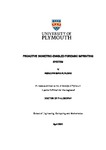PROACTIVE BIOMETRIC-ENABLED FORENSIC IMPRINTING SYSTEM
| dc.contributor.supervisor | Clarke, Nathan | |
| dc.contributor.author | Alruban, A | |
| dc.contributor.other | School of Engineering, Computing and Mathematics | en_US |
| dc.date.accessioned | 2020-04-14T07:45:01Z | |
| dc.date.issued | 2020 | |
| dc.date.issued | 2020 | |
| dc.identifier | 10510667 | en_US |
| dc.identifier.uri | http://hdl.handle.net/10026.1/15562 | |
| dc.description.abstract |
Insider threats are a significant security issue. The last decade has witnessed countless instances of data loss and exposure in which leaked data have become publicly available and easily accessible. Losing or disclosing sensitive data or confidential information may cause substantial financial and reputational damage to a company. Therefore, preventing or responding to such incidents has become a challenging task. Whilst more recent research has focused explicitly on the problem of insider misuse, it has tended to concentrate on the information itself—either through its protection or approaches to detecting leakage. Although digital forensics has become a de facto standard in the investigation of criminal activities, a fundamental problem is not being able to associate a specific person with particular electronic evidence, especially when stolen credentials and the Trojan defence are two commonly cited arguments. Thus, it is apparent that there is an urgent requirement to develop a more innovative and robust technique that can more inextricably link the use of information (e.g., images and documents) to the users who access and use them. Therefore, this research project investigates the role that transparent and multimodal biometrics could play in providing this link by leveraging individuals’ biometric information for the attribution of insider misuse identification. This thesis examines the existing literature in the domain of data loss prevention, detection, and proactive digital forensics, which includes traceability techniques. The aim is to develop the current state of the art, having identified a gap in the literature, which this research has attempted to investigate and provide a possible solution. Although most of the existing methods and tools used by investigators to conduct examinations of digital crime help significantly in collecting, analysing and presenting digital evidence, essential to this process is that investigators establish a link between the notable/stolen digital object and the identity of the individual who used it; as opposed to merely using an electronic record or a log that indicates that the user interacted with the object in question (evidence). Therefore, the proposed approach in this study seeks to provide a novel technique that enables capturing individual’s biometric identifiers/signals (e.g. face or keystroke dynamics) and embedding them into the digital objects users are interacting with. This is achieved by developing two modes—a centralised or decentralised manner. The centralised approach stores the mapped information alongside digital object identifiers in a centralised storage repository; the decentralised approach seeks to overcome the need for centralised storage by embedding all the necessary information within the digital object itself. Moreover, no explicit biometric information is stored, as only the correlation that points to those locations within the imprinted object is preserved. Comprehensive experiments conducted to assess the proposed approach show that it is highly possible to establish this correlation even when the original version of the examined object has undergone significant modification. In many scenarios, such as changing or removing part of an image or document, including words and sentences, it was possible to extract and reconstruct the correlated biometric information from a modified object with a high success rate. A reconstruction of the feature vector from unmodified images was possible using the generated imprints with 100% accuracy. This was achieved easily by reversing the imprinting processes. Under a modification attack, in which the imprinted object is manipulated, at least one imprinted feature vector was successfully retrieved from an average of 97 out of 100 images, even when the modification percentage was as high as 80%. For the decentralised approach, the initial experimental results showed that it was possible to retrieve the embedded biometric signals successfully, even when the file (i.e., image) had had 75% of its original status modified. The research has proposed and validated a number of approaches to the embedding of biometric data within digital objects to enable successful user attribution of information leakage attacks. | en_US |
| dc.description.sponsorship | Embassy of Saudi Arabia in London | en_US |
| dc.language.iso | en | |
| dc.publisher | University of Plymouth | |
| dc.subject | Digital Forensics | en_US |
| dc.subject | Biometrics | en_US |
| dc.subject | Insider misuse | en_US |
| dc.subject.classification | PhD | en_US |
| dc.title | PROACTIVE BIOMETRIC-ENABLED FORENSIC IMPRINTING SYSTEM | en_US |
| dc.type | Thesis | |
| plymouth.version | publishable | en_US |
| dc.identifier.doi | http://dx.doi.org/10.24382/986 | |
| dc.rights.embargodate | 2021-04-14T07:45:01Z | |
| dc.rights.embargoperiod | 12 months | en_US |
| dc.type.qualification | Doctorate | en_US |
| rioxxterms.version | NA | |
| plymouth.orcid.id | 0000-0002-7295-5194 | en_US |
Files in this item
This item appears in the following Collection(s)
-
01 Research Theses Main Collection
Research Theses Main


